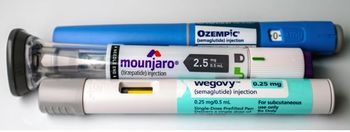
The Journal of Respiratory Diseases
- The Journal of Respiratory Diseases Vol 29 No 3
- Volume 29
- Issue 3
Using elastic compression stockings to prevent post-thrombotic syndrome
The reported incidence of postthrombotic syndrome (PTS) after a first episode of deep venous thrombosis (DVT) is quite variable, depending on the measurement scale used and the severity. Most studies suggest that the rate is 20% to 50%, with symptoms ranging from minor skin discoloration to chronic swelling and ulceration.1 However, the incidence of symptomatic PTS was less than 5% in a population of patients who underwent orthopedic hip and knee arthroplasty, regardless of whether they experienced symptomatic postoperative DVT.2
How effective are elastic compression stockings in the prevention of post-thrombotic syndrome? Do you recommend their routine use?
The reported incidence of postthrombotic syndrome (PTS) after a first episode of deep venous thrombosis (DVT) is quite variable, depending on the measurement scale used and the severity. Most studies suggest that the rate is 20% to 50%, with symptoms ranging from minor skin discoloration to chronic swelling and ulceration.1 However, the incidence of symptomatic PTS was less than 5% in a population of patients who underwent orthopedic hip and knee arthroplasty, regardless of whether they experienced symptomatic postoperative DVT.2
In a randomized controlled trial, below-knee elastic compression stockings reduced the incidence of PTS from 49% to 26% overall in patients with DVT, and it reduced the incidence of severe sequelae from 12% to 3.5%.3 After adjustment for baseline characteristics, the hazard ratio (HR) for PTS was 0.49 (95% confidence interval [CI], 0.29 to 0.84). The elastic stockings were well tolerated, and all but one event occurred within the first 2 years.
Based on this randomized trial, the potential benefit of elastic stockings in preventing PTS is clinically meaningful, with a number needed to treat of only 4. The stockings used in this trial were 30 to 40 mm Hg at the ankle, which is the fourth highest of the 5 levels of compression stockings (level 5 is more than 40mm Hg and requires a prescription).
Adherence and cost need to be considered and discussed with the patient. The cost of elastic compression stockings is $15 to $50 per pair, and over a 2-year period, a patient will likely use a number of pairs. Also, some patients have difficulty in putting the stockings on because of the high level of compression.
Finally, elastic compression stockings are not without some risk. In a small study of 89 patients who underwent orthopedic hip or knee replacement, 98% did not achieve the ideal pressure gradient from ankle to knee, and 54% had a reversed gradient on at least one occasion.4 The rate of thrombosis was significantly higher in patients with stockings that produced a reversed gradient than in patients whose stocking produced a correct gradient (25.6% vs 6.1%; P = .026). This study suggests that elastic compression stockings that do not fit properly are less effective in preventing DVT and are potentially less effective in preventing PTS, although the latter was not assessed in the study.
In summary, I recommend all patients with acute DVT wear 30 to 40 mm Hg elastic compression stockings for as long as they are able to for up to 2 years. If the stockings are uncomfortable or create a tourniquet-like effect around the leg, I recommend they not be worn. Ideally, we would know which patients are at greatest risk for PTS and target those patients. In the above-mentioned randomized trial, the rate of PTS increased with recurrent ipsilateral DVT (HR, 3.32; 95% CI, 1.04 to 10.62; P = .04) and for every 10-year increase in age (HR, 1.36; 95% CI, 1.15 to 1.60; P = .003).3 Based on these data, it would be reasonable to be more forceful with the recommendation to use compression stockings in patients with recurrent DVT and in older patients. Like all recommendations that require patient adherence, a discussion of the pros and cons of wearing elastic stockings should take place, with the recommendation acknowledging patient preferences.
References:
REFERENCES
1.
Kahn SR, Solymoss S, Lamping DL, Abenhaim L. Long-term outcomes after deep vein thrombosis: postphlebitic syndrome and quality of life.
J Gen Intern Med.
2000;15:425-429.
2.
Ginsberg JS, Turkstra F, Buller HR, et al. Postthrombotic syndrome after hip or knee arthroplasty: a crosssectional study.
Arch Intern Med.
2000;160:669-672.
3.
Prandoni P, Lensing AW, Prins MH, et al. Below-knee elastic compression stockings to prevent the postthrombotic syndrome: a randomized, controlled trial.
Ann Intern Med.
2004;141:249-256.
4.
Best AJ, Williams S, Crozier A, et al. Graded compression stockings in elective orthopaedic surgery. An assessment of the in vivo performance of commercially available stockings in patients having hip and knee arthroplasty.
J Bone Joint Surg Br.
2000;82:116-118.
Articles in this issue
over 17 years ago
Allergy immunotherapy: Indications, efficacy, and safetyover 17 years ago
Oropharyngeal candidiasis: Diagnostic clues, treatment tipsover 17 years ago
A patient with hemoptysis, anemia, and renal failureover 17 years ago
Chronic cough: Seeking the cause and the solutionNewsletter
Enhance your clinical practice with the Patient Care newsletter, offering the latest evidence-based guidelines, diagnostic insights, and treatment strategies for primary care physicians.































































































































































































































































































